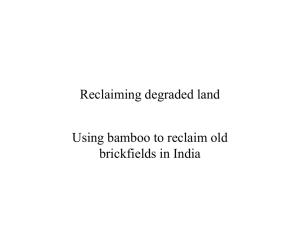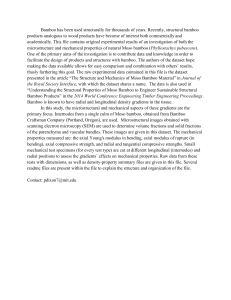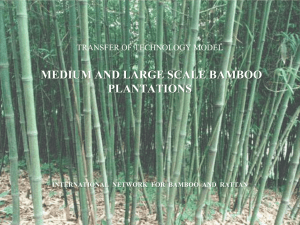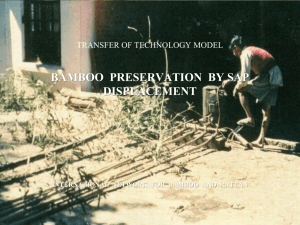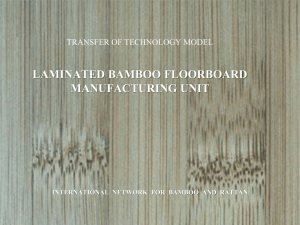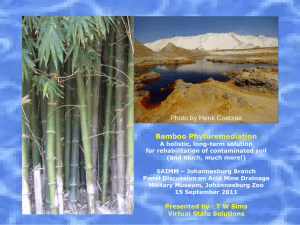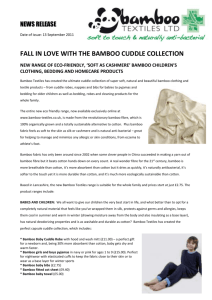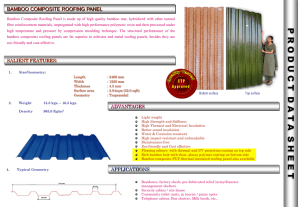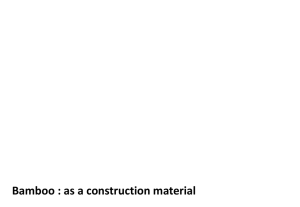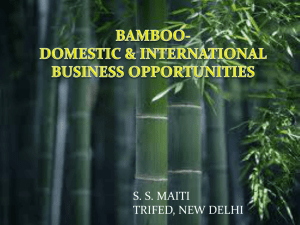Bamboo Splitting PPT - International Network for Bamboo and Rattan
advertisement
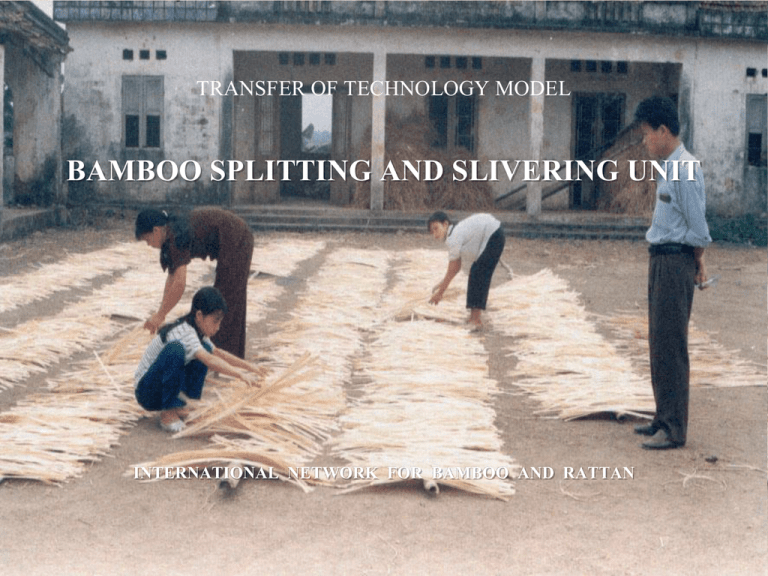
TRANSFER OF TECHNOLOGY MODEL BAMBOO SPLITTING AND SLIVERING UNIT INTERNATIONAL NETWORK FOR BAMBOO AND RATTAN Why bamboo? • Bamboos grow more rapidly than trees and start to yield within three or four years of planting. • Plantation establishment requires minimal capital investment and builds upon the inherent plant-cultivation skills of local farmers and foresters. • Bamboos can be harvested annually and non-destructively. • Bamboos are excellent for rejuvenating degraded lands and protecting against soil erosion. • Bamboos may easily be intercropped with shallow-rooted crops. • As well as the culms, all other parts of the bamboo plant can be used in rural livelihoods - shoots for food, leaves for fodder, and branches for items such as brooms and for firewood. What are bamboo splits and slivers? • Bamboo splits and slivers are longitudinal sections of a bamboo culm. • Bamboo splits are produced when the culm is initially sectioned. They are the full thickness of the culm wall and have the green outer layer still attached. They are a primary stage in the production of slivers. • Bamboo slivers are long, thin strips of bamboo, much thinner than they are broad. They are very pliable and can be used to weave a wide range of products, including the mats used to produce bamboo matboard. How are splits and slivers produced? 1. Bamboos are crosscut into sections 2. Sections are split into splits 3. Splits are split into slabs 4. Slabs are split longitudinally to produce slivers of the desired thickness Main development attributes of a splitting and slivering unit • Reduces dependence on timber resources and thereby increases environmental protection and conservation. • Permits rehabilitation of degraded lands through increased areas of bamboo plantations. • Creates income-generating opportunities for bamboo growers who will supply the unit, and employment for unskilled, semi-skilled and technical staff at the unit. • Provides a regular supply of slivers to weavers who will not have to split bamboos themselves and so can use their time more efficiently and productively in weaving. • Can be established as a central community enterprise to supply a wide range of different community bamboo-weaving enterprises. Some salient facts • Hand splitting and slivermaking has been practiced for millenia but is time consuming and only suitable for small scale production. • The splitting and slivering unit is suited only to the splitting of large culmed species of bamboo. It is not suitable for areas in which only small, narrow culmed bamboos are grown, such as high altitude regions of the temperate and subtropical zones. Photo: Sets of splitting knives • As a primary processing activity, the splitting and slivering unit is ideally established as one of the central core units in a broader, communitybased, bamboo development programme, along with a bamboo preservation unit and a bamboo propagation unit. • The unit may also be established to supply, or as a subsidiary part of, a matboard or roofing sheets unit. Such units utilise large quantities of woven mats produced from slivers. Mat weaving is often a major source of income for women who can weave at home. Requirements for success • Sustained supply of bamboos suitable for splitting. • Some technically-trained personnel to manage and maintain the unit. • Start up capital. • Well established linkages to the secondary processors who are the “market” for the slivers produced. Above: Coarse bamboo splits. Left: Weaving mats Financial aspects of a splitting and slivering unit (based on a unit exclusively supplying a matboard factory) • • • • Capital costs for machines Land and buildings Working capital margin Preliminary and preoperative costs • TOTAL $130, 000 $110, 000 $ 25, 000 $ 35, 000 $300, 000 Notes: * The costs shown above are based on a large unit providing a sufficient number of slivers to produce 1, 300 mats (1.2 x 2.4m) per day. * Facilities with lower production rates can be established for considerably less. * Costs will vary with location and source of machines. For further information See Contact • INBAR, Beijing 100101-80, China • IPIRTI, P.B. No. 2273, Tumkur road, Bangalore, India TOTEMs Splitting and Slivering unit TOTEM Matboard TOTEM Woven Bamboo Products TOTEM Village bamboo preservation unit TOTEM Bamboo preservation by sap displacement TOTEM Book Local Tools, Equipment and Technologies for Processing Bamboo and Rattan. INBAR Technical Report 9, 1997. (text file available at www.inbar.int. Covers hand-splitting only)
